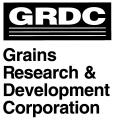CRC50060: Cool Grain Fumigation
Increasing applications of phosphine to stored grain in silos that leak, or grain stored under the wrong conditions, has caused problems with insect pests building up resistance. Proof is needed to show whether phosphine fumigation of cool grain is effective in controlling resistant biotypes of insect pests of stored grain.
Research outcomes:
This project assessed the efficacy of phosphine fumigation against resistant insects in cool grain, i.e. aerated grain or grain that has been harvested and stored in the cooler months of the year, and developed recommendations for Australia’s grain storage industry. Grain temperatures of
20°C or less are considered cool. The project will contribute to keeping Australia’s grain export industry free from insect strains resistant to phosphine. Increasing applications of phosphine to stored grain in silos that leak, or grain stored under the wrong conditions, has caused problems with insect pests building up resistance. Proof is needed to show whether phosphine fumigation of cool grain is effective in controlling resistant biotypes of insect pests of stored grain.
The project has:
- provided reports describing new data on phosphine efficacy at low temperature against resistant grain insects
- provided reports describing new data on phosphine sorption by grain
- provided reports describing new data on phosphine fumigation of cool grain in sealed farm silos, and
- made recommendations to farmers and others within the grain industry.
Recommendations on phosphine fumigation of cool grain have been reported to representatives of the grain industry and national extension network at annual meetings of National Working Party on Grain Protection (NWPGP). Results, recommendations and technology transfer have been provided to the Australian grain industry via the NWPGP and industry forums and publications. CRC partners, bulk grain storage operators and handlers have been informed of the findings.
Research implications
Successful fumigation of resistant insects requires sufficient phosphine concentrations for long enough to control all life stages of the insects. Lower temperatures maintain grain quality and reduce insect population growth, but phosphine is generally less effective at lower temperatures.
The relative importance of phosphine resistant strains of key pests changes with temperature. The most resistant Australian strains of two pests are known to respond similarly to phosphine but the project showed that one species became much harder to control in cool grain.
Sorption will be the major cause of loss of phosphine in a wellsealed silo. Rate of sorption was lower at lower temperature, meaning that higher concentrations will be achieved for longer. Older grain tended to be less sorptive, so delaying fumigation may result in higher concentrations for longer. Sorghum was more sorptive than wheat so the margin for error is smaller for this grain.
In farm silos, phosphine gas was liberated from the aluminium phosphide formulations used despite the low grain and ambient temperatures (e.g. 10°C).
The results for the silo trials varied but three general observations were made. Lower concentrations tended to be measured deeper in grain mass. Lower concentrations tended to be measured on the northern side. Concentrations measured higher in the grain mass tended to peak earlier.
The silo trials showed that control of resistant insect populations is possible subject to good gas-tightness and adequate exposure periods. Exposure to cool temperature alone was not the cause of insect mortality.
Growers and others planning to fumigate cool grain in sealable silos should aim for the current silo pressure test standard of a three minute halving time for a full silo or a five minute halving time for a partially full silo.
The use of forced or passive recirculation methods (e.g. the thermosiphon) should be investigated to promote rapid and even distribution of phosphine from the headspace throughout the grain bulk.
Acknowledgements
The project team is grateful for the cooperation of the following growers and their families: Mr Rodney Petersen (Killarney, Qld) and Mr Raymond Fulwood (Meenaar, WA).
Publications for this project
PROJECT LEADER
Dr Greg Daglish
Project Leader CRC50060: Cool Grain Fumigation
greg.daglish@deedi.qld.gov.au
Phone: 07 3896 9415
Fax: 07 3896 9446
Read More
PROJECT DETAILS
Complete
Term
July 2007 – November 2008
Budget
$365,414 (cash and in-kind support)








